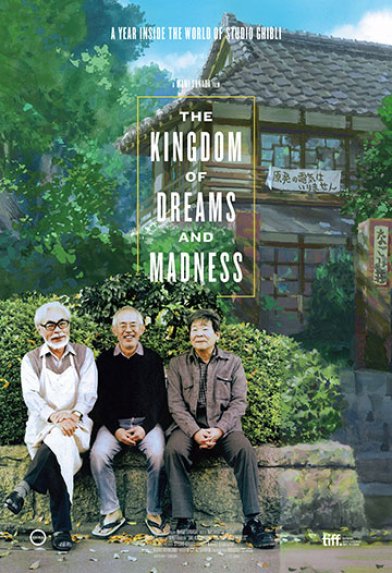Studio Ghibli is synonymous with anime. Mention a well known anime film and Hayao Miyazaki and Studio Ghibli are most likely behind it. The Kingdom of Dreams and Madness is a documentary about a year behind the scenes at the studio that coincidentally happened to coincide with the production of Miyazaki’s final film, The Wind Rises.
I’m not too familiar with anime. I love the way that it looks and its lyrical, beautiful colors that make the movie look like a true, moving watercolor painting. However, I’ve only seen one Studio Ghibli film and knew next to nothing about how anime films are created.
Given that background I really enjoyed The Kingdom of Dreams and Madness. It’s a fascinating look at the artistry behind anime, the person that is Miyazaki and just a glimpse at the working culture in Japan.
The bulk of the film follows Miyazaki, his producer Toshio Suzuki and Isao Takahata, another director who is rarely seen. During this year Ghibli is producing another film The Tale of Princess Kaguya that Takahata is in charge of. He’s rarely seen on camera and maybe has 15 minutes of screen time max.
For the most part this is Suzuki and Miyazaki’s film at the main Ghibli offices. The legendary aspects of the studio are mentioned often by film maker Mami Sunada, but she doesn’t shy away from the work that it takes to create them. She gets interviews with lots of animators who readily admit that the work is tiring, frustrating at times and requires lots of patience.
While watching the film I found myself wondering what the classic animators who worked under Walt Disney thought. Was the work the same? How did they make them and the myriad number of images that were produced to actually complete a film.
Dreams and Madness tracks the progress of The Wind Rises from mid-idea to completion. Story boards, coloring, vocal work and the struggles behind getting all of aspects of the film done on time are amazing to watch.
The film, to an extent, serves as a window into Japanese culture. The calisthenics that everyone, everyone does in the office, the food delivery person, Ushiko-the office cat, school children walking to school and the density of the buildings add to the travelogue of the film. It’s a real glimpse at modern Japanese living.
The people that Sunada profiles provide different visions and ideals about work and life. Suzuki is strong in business, Miyazaki is looking forward to retirement and quite often reflective about life and nihilistic about the future.
You don’t have to like anime or be a fan of Japanese culture to enjoy The Kingdom of Dreams and Madness. It’s a fly-on-the-wall view of entertainment and professionals on the verge of retirement. The film is so genuinely pleasant to watch in its execution, as well as, getting to see people do the work that they love doing.
Fans of animation will want to watch The Kingdom According to Ushiko. It’s an extra on the DVD and has more behind-the-scenes footage, scenes from when director of Toy Story, John Lassiter visited the studio and more. The other two extras are OK, but short and not nearly as good or long as the first one.





 Facebook
Facebook Twitter
Twitter Flickr
Flickr GooglePlus
GooglePlus Youtube
Youtube